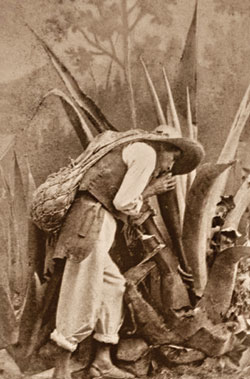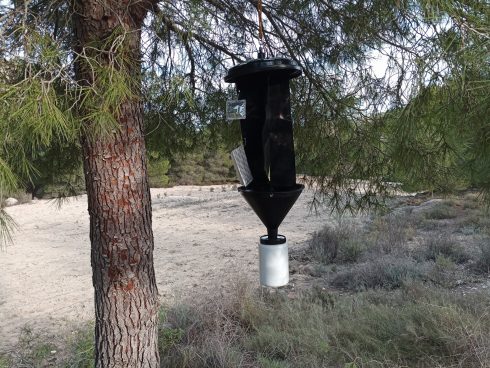… helps us work, rest and play claims prickly BOB MADDOX, who takes a peek at one of Andalucía’s most iconic plants
LEGEND has it that an ancient king of Mexico was once injured by the sharp spines of a plant.
Being a king, he was rather peeved and ordered his minions to destroy the offending vegetable instantly. As the unfortunate plant was being torn to shreds, the king noticed that it contained many strong fibres and this gave him a rather clever idea. He ordered these to be woven into a rope, which he then used to bind all other plants of a similar aggressive nature and so enslave them in the service of his people forever.
It turned out that the ancient king chose rather well, for the plant which once stabbed the royal leg now finds uses in fields as diverse as medicine, cookery and the construction and brewing industries. You can cure with it, cook with it, build with it or get stoned on it. The Aztecs even killed for it. Welcome to the wonderful world of the Agave; one of the most useful plants on the planet and, to its many fans, one of the most interesting and beautiful.
This is the plant that Spanish explorers brought home and spread throughout the Mediterranean. Today, it is one of the great iconic palnts of Andalucía.
Look out of your window and, if you live in Olive Press territory, the chances are that you will see one not too far away. That big, spikey punk of a plant with its three-metre flower stalk silhouetted against the sky is Agave americana, the most common of a family of more than 200 different agaves.
With its dense rosette of saw-edged, needle-tipped leaves, Agave americana is a battle tank of a plant – a patch of it is certainly no place to get caught short on your way home from the bar.
If Rambo had been a plant, he would have been an agave.
Spectacular
But let us look past the aggressive face agave presents to the World. Here, we will find a plant with a rich and fascinating story to tell – and one which is at its most spectacular between the months of May and July. This is the time when something wonderful happens across the arid hillsides and barrancos of Andalucia, as Agave americana reaches for the sky with one of the most spectacular flowering displays in the entire plant kingdom.
With a growth rate of up to ten centimetres a day, a terminal height of 10 metres and the girth of a telegraph pole, an agave flower spike is a true spectacle of nature.
From this cathedral spire, slender branches unfold to support pads of greenish-yellow flowers, which are aerial feeding stations for thousands of nectar hungry insects, moths, butterflies and even bats.
 It is spectacular and beautiful and it is out there now. Do not miss it, for it is dying to be seen – quite literally. As the big seeds begin to set, hormonal changes take place which will shortly kill the parent plant.
It is spectacular and beautiful and it is out there now. Do not miss it, for it is dying to be seen – quite literally. As the big seeds begin to set, hormonal changes take place which will shortly kill the parent plant.
Despite its long life, no agave ever flowers twice.
These are also superstars in the world of homoeopathic and herbal remedies: digestion out of whack? Agave sap is said to cure diarrhoea or constipation. Whether you are blown-out or blocked-up, agave has the answer. Indigestion? Dysentery? No problem – same solution.
Liver problems? Agave sap again. Angina? Pneumonia? Simply peel and slice an agave leaf, fry in olive oil until golden, then apply to the back and chest, thus sandwiching the afflicted organ between two pads of agave healing power. This practice is still used in areas of north-east Catalunya to this day.
Gentlemen, are you balding? Soak agave fibres in water then apply to the scalp to prevent your hair falling out. But before your rush out with a machete, do remember that the Aztecs used the same stuff as a glue.
Ladies, are you tired of lying under the same duvet as a gassy male? Agave it seems, is most efficacious in cases of chronic flatulence and, apparently, “checks the growth of putrefactive bacteria in the stomach and intestines.”
Glad I found out before the divorce came through.
And if you do happen to wander into an agave patch one dark night, those stab wounds and lacerations should respond well to agave sap. If your wounds turn septic, try a poultice of boiled agave root.
Hallucinogenic
But beware, for this is a plant with a dual personality. That good medico Dr Agave Jekyll, has a dark alter-ego; the nasty Mr Agave Hyde.
According to the august pages of the Journal of Herbal Pharmacother (what a title!), there is insufficient scientific evidence that agave is effective in any of the conditions mentioned above. Quite the contrary in fact, since Agave americana is known to produce skin irritation and dermatitis, while other agave species contain chemicals known as saponins, that damage or destroy blood cells.
But no such problems abound for builders or DIY enthusiasts. Need fence posts? Its flower stems will do nicely. Roof leaking? Agave leaves make excellent roof tiles and if you run short of nails, try fixing them with agave spines, which are quite sharp and hard enough to be driven into wood. Need a rope? Agave sisalana – or sisal – will provide you with that. Need a needle? Agave spines are sharp enough to sew leather.
And if after all this agave-based activity you fancy a drink, simply slide into a hammock (woven from sisal of course), relax in the shade of an agave-leaf parasol and sink a nice glass of pulque. Ahh! What’s pulque? Well…
If you feel that the nutritious sap of the agave flower-spike (aptly called aguamiel or honey water) is far too good for insects, bats and the like, then you can always harvest it yourself. Simply cut off the growing spike, hollow it out and wait for the aguamiel to collect.
Now ferment it to make the intoxicating beverage known as pulque – a tipple which clearly has something special going for it. As traveller Don Lotter recorded in Pan American Adventure:
“The first time I drank pulque, I knew there was something special about it, because it gave me power over alleyway dogs…”
A six-pack for me please!
If the hard stuff is to your taste, Agave tequilana gives us tequila. This is what we call the agave spirit Mezcal when it is produced near the Mexican town of, well, Tequila.
And while you are at it, you might like to drop an Aegiale hesperiaris into the bottle – that is the edible caterpillar that infests the heart of certain agaves and which is to be found lying in pickled splendour at the bottom of every bottle of second rate Mezcal.
But do not be taken in by this hallucinogenic mite: the finest Tequilas should be worm free.
Sacrifice
Certainly, the Aztecs liked their pulque. It was inextricably woven into the fabric of Aztec culture and religion – and the Aztecs were very big on religion. Oh, and on human sacrifice of course.
They were particularly partial to throwing big parties in honour of their god of sun and war, the fabulously named Huitzilopochtli (H to you and me).
Strangely, the Aztecs represented this macho divinity as a fragile hummingbird. Now, since the Aztecs consumed pulque in industrial quantities, and since pulque production involved removing the agave flower stem, then it followed that this deprived other creatures of agave nectar, including – yes, you guessed it – hummingbird gods.
To appease H, the Aztecs substituted another precious fluids for the nectar they had stolen. Namely human blood.
During these sacrificial parties everyone, including the victims, were encouraged to get thoroughly oiled on pulque. Often, thousands of victims would be offered up to appease H and apologise for nicking his nectar, their hearts ripped from their living bodies and their flesh cooked and eaten.
Such was the scale of some of these events that even that hoary old Spanish conquistador Cortes was said to have been utterly horrified.
During one big H dedication ceremony in 1487, more than 20,000 captives were sacrificed. In terms of apology and absolution, it certainly put the Catholic Confessional in the shade. Incidentally, the Aztecs also had an agave goddess called Mayahuel who had 400 nipples! But that is a story for another issue.
If cannibalism is not to your taste, you can always go vegetarian with an agave. Irrefutable evidence that humanity has chewed on agaves for at least 9,000 years is provided by the famous anthropologist Eric Callen, who spent years examining coprolites in minute detail and found traces of agave in them. Coprolites, as I am sure you know, are mummified human turds – which to my mind provides irrefutable evidence that Callen should have got out more. Or drunk more pulque.
In 1577, Spanish explorer Francisco Hernandez recorded native Mexicans as using agaves for honey, vinegar, wine and sugar. Leaves were baked, flower stems roasted and flowers scrambled with eggs.
Today, Anne Astle’s enchantingly titled cookbook The Everyday Agave lists lots of tempting recipes and I do confess to having tried a little sautéed agave stem myself.
How was it? Well, in the immortal words of Crocodile Dundee: “Sure you can eat it, but it tastes like $hit.”
But then maybe I just chose the wrong cut.
Well, what a plant! Whether you eat it, drink it, build with it or get smashed and sacrifice your neighbours, there is no denying its special place in the scheme of things. It can cure most ailments and cause plenty more. It may even stop your man farting. Not even penicillin can claim that.
But surely, the true beauty of the agave lies in what it gives to the landscape of Andalucia. So, get out that hammock, open that can of pulque, relax and view a sunset through the cathedral spires of an agave in full flower. You can do it right now. Huitzilopochtli! It almost makes me wish I was born a butterfly or a bat. Or maybe even a hummingbird.
Cooking with agave
A NATURAL alternative to sugar and artificial sweeteners, diabetic friendly agave nectar is available commercially, but it is probably not stocked on every shelf in shops in the south of Spain. Import bottles from groovyfood.co.uk, a company which describes the honey-like sap as “tongue-jinglingly delicous.” Below are two recipes that make good use the nectar.
Agave smoked salmon
- Quarter cup of butter or margarine
- Quarter cup of agave nectar
- Half a cup of breadcrumbs
- One tablespoon of BBQ sauce
- Two teaspoons of salt
- Four salmon fillets, skinned
Place the butter in a sufficiently-sized baking tray and place under a preheated grill until the butter is melted. Remove from under the grill. In a small bowl, mix together the agave nectar, BBQ sauce and salt. Place the breadcrumbs in a seperate small bowl. Rub the salmon fillets with the agave mixture, ensuring you coat all the fish. Roll each of the fillets in the breadcrumbs and then place the salmon in the baking tray, covering both sides with melted butter. Place back under the grill and cook for 10-15 minutes, until the fish is done.
Agave nut glazed brie
- Quarter cup of agave nectar
- Quarter cup of pecan nuts, coarsely chopped
- One tablespoon of brandy
- A nice sized round of brie cheese
In a bowl, combine the agave, chopped pecans and brandy. Place the cheese on a sufficiently-sized ovenproof platter. Bake in a preheated hot oven for about five minutes, or until the cheese softens. Drizzle the agave, brandy and nut mixture over the cheese and bake for a few minutes longer. Make sure the cheese does not melt. Like all good things in life, serve with a glass of chilled white wine.
Recipes courtesy of www.volcanicnectar.com








It’s good to be the king :-)